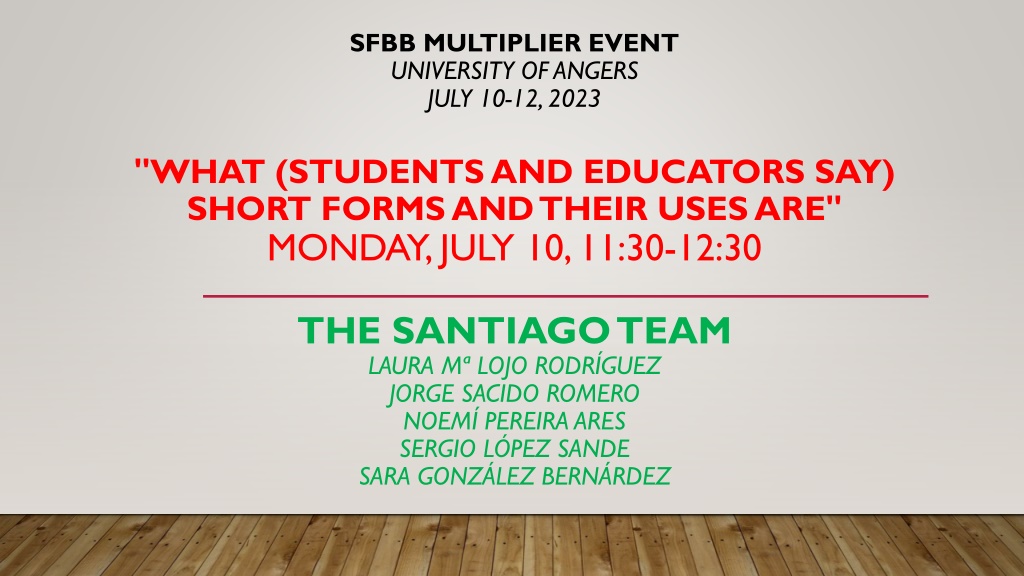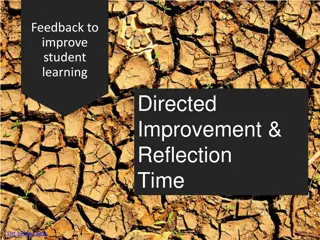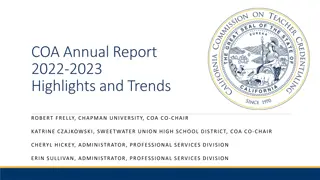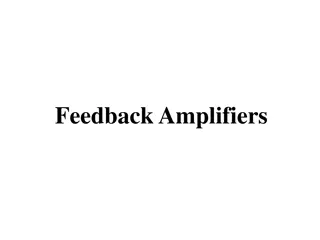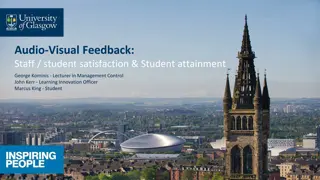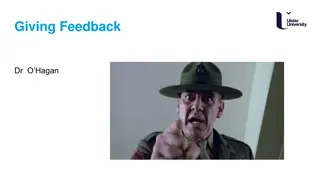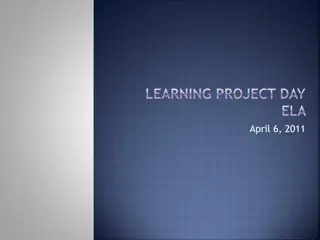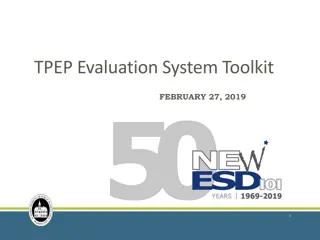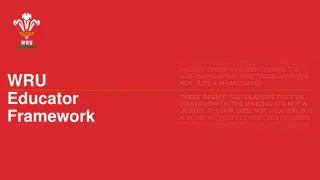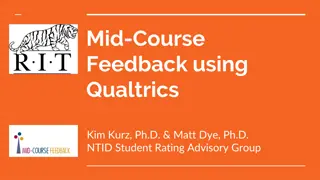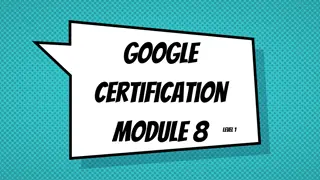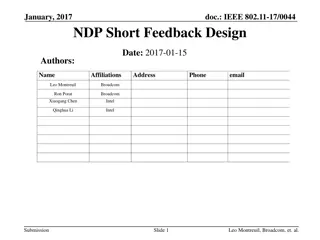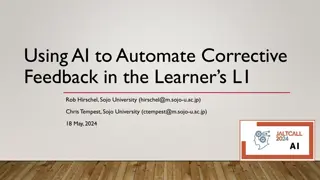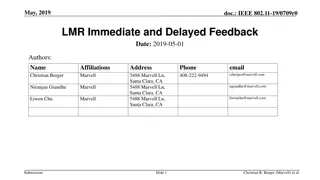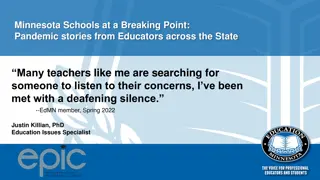Exploring Short Forms and Their Usage in Student and Educator Feedback: A Comprehensive Analysis
Delve into the world of short forms and their application through an in-depth study involving students and educators. Uncover insights from surveys conducted at University of Santiago de Compostela and IES Rosalía de Castro. Discover varying perceptions on brevity among educators and students, shedding light on their reading habits and preferences.
Download Presentation

Please find below an Image/Link to download the presentation.
The content on the website is provided AS IS for your information and personal use only. It may not be sold, licensed, or shared on other websites without obtaining consent from the author. Download presentation by click this link. If you encounter any issues during the download, it is possible that the publisher has removed the file from their server.
E N D
Presentation Transcript
SFBB MULTIPLIER EVENT UNIVERSITY OF ANGERS JULY 10-12, 2023 "WHAT (STUDENTS AND EDUCATORS SAY) SHORT FORMS AND THEIR USES ARE" MONDAY, JULY 10, 11:30-12:30 THE SANTIAGO TEAM LAURA M LOJO RODR GUEZ JORGE SACIDO ROMERO NOEM PEREIRA ARES SERGIO L PEZ SANDE SARA GONZ LEZ BERN RDEZ
IO1: Definitions & Surveys Definitions: if time left, comment Booklet (booklet.pdf): 5 approaches and their respective pros/cons (relativist, generic [genre], paratextual, functionalist, and contrastive-formalist )
"What (Students and Educators Say) Short Forms and Their Uses Are: second part of the IO: Surveys results (specifically, shared with you all my presentation to a much smaller audience: Giessen TN event) HISTORY: Leuven Meeting 8-9 November 2021: presentation of a draft of students and educators surveys during the meeting Nov. 2021-Feb 2022: 2nd rough draft revised and completed by some colleagues from the field of Sociolinguistics at the USC Feb. 2022: surveys distributed through Google.docs among Faculty and Students at the Faculty of Philology (USC) and High School IES Rosal a de Castro (Santiago de Compostela) Data collected by Sergio L pez Sande worked as administrator and collected the data + Surveys Report drafted by Sara Gonz lez Bern rdez Giessen Meeting (March 28-April 1, 2022) and Santiago Multiplier Event (July 4-5 July 2022):reports on IO1 by Jorge Sacido Romero and Sara Gonz lez Bern rdez, respectively
Relevant aspects of the report on Surveys Limited scope (just 1 Faculty and 1 Secondary School and low participation) Population: Surveys for students: Faculty of Philology (USC): 119 out of 1585 (undergraduate, graduate and Erasmus): 7,5% IES Rosal a de Castro: 49 out of 390 (three last years of secondary school): 12,56% Surveys for educators: Faculty of Philology (USC): 49 out of 191: 24,1% IES Rosal a de Castro: 14 out of 116: 11,76% Gender: vast majority female
Special attention to similarities and contrasts between/among the different sectors or interest groups (in green type; some in red)
Perception of brevity: varies quite significantly from educators to students, and also amongst educators themselves EDUCATORS written texts: USC: up to 10 minutes to read: 43.5% / less than 5 minutes to read: 34.8% IES Rosal a de Castro (high school): up to 10 minutes to read: 28.6% /less than 5 minutes to read: 64.3% Contrast Univ./Secondary school: a difference inherent to the educational level they teach in: a need to cover more content in a shorter amount of classroom time, or perhaps a perceived shorter attention span in their students audio-visual content: USC: up to 10 minutes to watch: 30,4% / less than 5 minutes to watch: 47.8% IES Rosal a de Castro (high school): up to 10 minutes to watch: 14.3% /less than minutes to watch: 71.4% Contrast Univ./Secondary school: same as with written texts
STUDENTS written texts: USC: up to 10 minutes to read: 34.5% / read at one sitting: 19.3% / less than 5 minutes to read: 17.6% /up to 30 minutes to read: 10.1% IES Rosal a de Castro (high school): up to 10 minutes to read: 36.7% / less than 5 minutes to read: 30.6% / up to 30 minutes to read: 12.2% /read at one sitting: 8.2% Conclusion: distribution of percentages of reading time-spans other than up to 10 minutes in University is more evened out than in the case of secondary school students Contrasts: (1) higher percentage of less than 5 mins. in secondary school students (30.6%) is in tune with their teachers' perception (2) 12.2 % of up to 30 mins. in secondary school students is relevant due to the smaller number of responses (49 vs. 119 at USC) => greater difference in reading level and speed among secondary school students themselves
STUDENTS audio-visual content: USC: between 5 and 10 minutes: 36.1% / between 10 and 15 minutes: 18.5% IES Rosal a de Castro (high school): between 5 and 10 minutes: 30.6%/ between 10 and 15 minutes: 32.7% Conclusions: (1) similarity between university and secondary school students in the option between 5 and 10 mins. (36.1% and 30.6%) is not surprising given that the consumption of audio-visual content has a fixed length, whereas reading speed can vary (2) contrast in the option between 10 and 15 mins. (18.5% and 32.7%) may be due to younger students being more accustomed to consuming more audio-visual content, or to attention spans with focus becoming shorter as they grow older
Use or perception of use of short forms: Both educators and students were asked to tick every option they had seen employed, or employed themselves, in a teaching context, out of a limited list of items that was made as inclusive as possible forms seen employed or employed themselves: most respondents (educators and students) ticked every or almost every option (e.g., USC students: 77.3% and IES Rosal a de Castro: 65.3%) in Other , the following were suggested: surveys and games (USC prof.), digital versions of MSs or parchments (USC prof.), animations, simulations and self-correcting exercises (IES R. de C. teacher), Kahoot (IES R. de C. student: time limit & questions to be answered quickly)
perceived frequency of use: Educators: USC and IES Rosal a de Castro: similar very often : 43.5% (USC) and 42.9% (IES R. de C.) sometimes : 30.4% (USC) and 28.6 % (IES R. de C.) Students: USC and IES Rosal a de Castro s : less perceived frequency than educators sometimes : 45.5% (USC) and 51% (IES R. de C.) often : 29.4% (USC vs. 43.5% educators) and 24.5% (IES R. de C. vs. 51% teachers) rarely : 15.1% (USC vs. 0% educators) and 20.4% (IES R. de Castro vs. 0% teachers)
online learning, forced by the pandemic, has increased frequency of use: Educators: as much now as before the pandemic (USC: 78.3%; IES R. de C.: 50% [more now: 50%]) Students: more now than before the pandemic Conclusion: the idea educators (esp. at University) have of their use of short materials may be inaccurate, or at least considered so by their students, though both collectives ticked similar options in the section forms seen employed or employed themselves
EDUCATORS PERCEPTION perception of usefulness and applicability of short forms: 69.5% of USC and 71.4% of IES R. de C. strongly agree that short forms are effective teaching tools perception of usefulness and applicability compared to longer forms: more divided: USC: 43.5% neither agree nor disagree ; 30.4% strongly agree IES Rosal a de Castro: 42.9% strongly agree ; other options more evenly distributed => perhaps due to the lower age of their students and their attention spans being perceived as shorter in general (consistent with the perception of brevity above)
if short forms had been considered (more) effective/productive, tick the reason(s) why out of a limited set of options and/or add Other : most respondents ticked almost every option: students would be more engaged and feel less intimidated by shorter forms USC (73.9%) and IES R. de C. (71.4%): students are more familiar with these short forms in their usual communicative contexts, which is helpful for them in the classroom Other options: short forms are useful because it is possible to cover their analysis in one class session that students pay more/better attention if the form is brief short forms are not necessarily more effective, but rather complementary to longer forms and other materials
which short forms in a list they consider most productive for teaching: most respondents ticked (almost) every option Conclusion: educators responses match those of the students, but, while willing to attribute some advantages to short forms, generally hesitant to place them above or as more useful than longer forms (=> a reluctance to leave longer forms behind) belief that relying overmuch on short forms can in fact be detrimental to students learning
STUDENTS PERCEPTION perception of usefulness and applicability of short forms: overwhelmingly positive: useful or very useful , and strongly agree that the use of these forms makes their learning experience more engaging if short forms had been considered (more) effective/productive, tick the reason(s) why out of a limited set of options and/or add Other : startlingly similar between both educational levels (Univ. & Sec. School) USC (57.1%) and IES R. de C. (53.5%): feel generally more attracted to these forms, which engages them in learning; USC (30.5%) and IES R. de C. (34.9%): their length will allow them to consume these forms in their entirety EDUCATORS perception ( students are more familiar with these short forms ) is not really a priority among STUDENTS themselves (meagre 5.7% USC and 7% R. de C.)
perception of usefulness and applicability compared to longer forms: contrast with EDUCATORS, whose replies where more divided, STUDENTS considered short forms are more effective (50/119 USC students and 20/49 IES R. de C. students agreed or strongly agreed ) Possible reasons: liable to be more interested in them can be consumed in less time (working time in each subject is a pressing issue for them in their learning experience)
Conclusions: 1) Perception of brevity: -variable among interest groups -shorter length in secondary school interest groups 2) Use or perception of use: -every suggested format was chosen, other formats added -students perceived that short forms were less frequently used, but more so than before the pandemic 3) Perception of usefulness and applicability: -very positive in all interest groups, yet overwhelmingly positive in students -compared to longer forms: more divided (educators more hesitant) -students are not really conscious of educators conviction that they are more familiar with short forms
Structure and Contents of Booklet (deliverable): booklet.pdf Title: What Are Short Forms? Definitions & Examples Introduction : the following cannot be obviated: 1) short forms are too complex and disparate cultural products to lend themselves to onefold definitions as the notion of shortness is unstable and context-bound 2) the 21st-century reinforced imperatives of immediacy and rapid consumption and dissemination have worked in favour of the utility of short forms as cultural objects 3) As a consequence, the defining quality of short forms (shortness) can be approached from different perspectives. We propose 5 of these approaches dividing their presentation into 3 parts: definition of the approach, examples, and notes concerning their potential and limitations
1) Relativism: reader(s)-/audience-dependant: short would be that form an individual or community considers as such within a given context => pros: descriptive specificity based on cultural perception; cons: determined by subjective judgement which impedes transhistorical extrapolation(s)
2) Genre Studies: taxonomic: short would be that form classified as such because it exhibits the features of established generic categories => pros: it works in many cases (e.g., the short story ); cons: genre is often unaware of its own historical specificity so that it may fail to accommodate new manifestations (esp. digital)
3) Paratextual Study: contextual and individualising: short is a given form considered as such by a community at the moment in which it appears because of the way it treats spatiotemporal brevity within a specific context (e.g., short poem , short tweet , short film , etc.) => pros: accounts for the specificity of each individual unit in its response to an environment; cons: shortness impossible to define (too many contextual variables and individual idiosyncrasies) and definitional features of a short unit are not immanent to the instance itself
4) Functionalism: pragmatic: short forms would be those which deploy brevity for a specific aim or to have a particular effect. They are short insofar as they make brevity function => pros: it highlights what short form do; cons: shortness as a feature cannot be isolated or transferred as it is tied to its function(s)
5) Contrastive Formalism: based on extension: short forms as those different from long(er) => pros: forcefully evident; cons: reductive and exclusionary of forms not inscribed in a tradition of length
Contributions on Definitions by other teams: Giessen on micro-fiction and short forms in general: Extreme, palpable action (vs. subtle adjustments in attitude or alterations in perception by characters ) Flat, anonymous characters (vs. fully delineated, three-dimensional characters) Generic spaces and indistinct settings (vs. detailed settings and metaphoric and impressionistic space) Short, compressed duration of events and discourse and lack of background (vs. more complex and expansive temporality) Tendency towards intertextual references (vs. well , what exactly?) Narrative closure (vs. openness)
Quantitative approaches: Word count: 2500 words (Short Shorts,1982) 1500 words (Sudden Fiction, 1986) 750 words (Flash Fiction, 1992) 300 words (Micro Fiction, 1996) 280/140 characters (Twitter fiction) Reading time: four-minute fiction
Socio-cultural approaches: -short(-short) fiction in a changing cultural and media ecology: access to contemporary feeling states more effectively than the conventional story does (D. Shields) -Microfiction in digital media(e.g., Twitter) The cognitive and cultural work of (short) forms: Microfiction as an epistemological form that reflects on the status and generic construction of knowledge (Basseler 2018) Short(est) forms of fiction do not simply contain or embody a certain form or mode of knowing, they construe and prefigure it in the first place (e.g., through formal properties and conventions). the affordances of short forms (Basseler): Def.: Short forms include all aesthetic and social forms that deliberately and observably exploit the rules of economy, thereby creating affordances and constraints regarding the arrangement and structure of our sociocultural reality
Useful aspects for teaching and/or cultural mediation: Ubiquity + formal brevity => easily grasped (though may complex or deep), consumed, and disseminated (examples of short forms affordances) Short forms travel easily and quickly across medial, national, and cultural borders (e.g., Bella Ciao in Covid-19: call to solidarity and resilience, yet danger of suggestiveness, manipulation and simplification) Forerunners of contemporary short forms (von Hagen): short telephone monologues in the theatre (= text message ) postcard (1869), petite poste (1761), small Viennese post (1784) feuilleton novel (= serial formats ) novella (a historical example of the variability in measuring brevity: e.g. 25 pp. in 16th-c. France, 200 pp in 17thc. )
Leuven onshort forms: Structural/formalist approach:on the notion of brevity as something that is shared by short forms in different genres (gnomic, lyrical, narrative, dramatic texts) (P. Zumthor s brevitas) Generic approach: on short genres and their development in literary history; yet flexible structures (traditional forms can be recovered, redeployed and adapted to suit new writers and new contexts) + quite common degree of generic hybridity (e.g., microfiction crossing over into essay or short stories drawing on characteristics of poetry) Contextual approach: publication context: together with other texts, polytextual publication context (Bruno Monfort) => affects their reception, production, and development
Functionalist approaches: how they function, what they can do, what their affordances are (Caroline Levine, Forms, 2015; Michael Basseler, An Organon of Life Knowledge, 2019) Def.: Short forms are narratives structurally shaped by brevity: they use techniques of condensation, selection, synthesis, or ellipsis to create unity and to resort maximum effect (affective, rhetorical, epistemological, ) with a minimum of means. Short forms in teaching practice in Belgium: Secondary education: not frequently used; preference for extracts from novels or plays (except for lyrical texts) University: preference for extracts from canonical novels, yet short poems and short stories are used to teach the methods and techniques of literary analysis, or in specialized MA-level courses
Athens onpedagogical use of short forms in language classes: mostly used at the beginning of learning (poems, songs, post-cards, nursery rhymes, riddles, advertising slogans etc.), yet gradually abandoned in favor of extracts of longer texts, as the learning progresses risks: because short, belief that language is simpler and more understandable => missing cultural nuances (humor, puns, linguistic ambiguity ) if too simple or childish, the students interest may decrease feeling of intellectual inferiority if not adapted to learners level and interests not considered by teachers as a separate type of expression that could contribute to the development of specific skills if their specificities were taken into account, objectives, such as the intercultural education and the plurilingualism, could be achieved
Angers onshort forms: There is nothing simple about the definition of short form as a concept, especially if it is considered in a transdisciplinary way : Many questions are raised: Brevity intersects with other notions, sometimes verging on the paradoxical: simplicity, conciseness, intensity, density The question perfection (e.g., a sonnet) or imperfection (e.g., fragmentation [connected to impressionism in painting], which is paradoxically related to the epiphanic, the revelation the fragment may evoke the whole [=holy relics]) Synecdoche (the part for the whole) is fundamental in defining short fiction (Pierre Tibi): particular relationship to the long forms in which they are often inscribed, + in the field of communication, messages - tweets, SMS, posts - are rarely isolated and rather function according to principles of seriality
Lack in breadth often compensated by depth in 3 ways: intrinsic relating it to a set to which it belongs (collection, series, sequence, chronicle...) via effects of intertextuality or inter-iconicity with other forms of expression characterized by "polygeneity : capacity to go from one to multiple and by assimilating different genres: the fable, the tale or the anecdote, etc. => functions like a crucible, like a laboratory where authors experiment with new techniques of representation.
